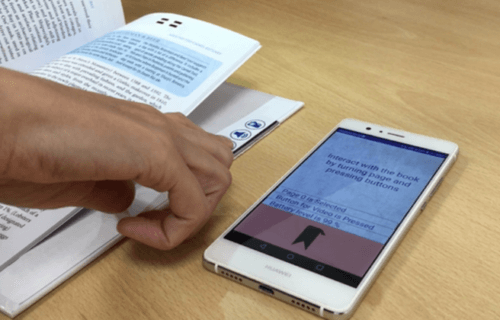GUILDFORD, United Kingdom — This new study is definitely a page turner. Researchers from the University of Surrey say augmented reality could soon be the future of paper books.
Researchers have unveiled the third generation (3G) version of its Next Generation Paper project. It allows the reader to consume information on the printed paper and screen side-by-side. This might allow printed books to make a comeback against the popularity of e-books.
“The way we consume literature has changed over time with so many more options than just paper books. Multiple electronic solutions currently exist, including e-readers and smart devices, but no hybrid solution which is sustainable on a commercial scale,” says Dr. Radu Sporea, senior lecturer at the Advanced Technology Institute, in a university release.
“Augmented books, or a-books, can be the future of many book genres, from travel and tourism to education. This technology exists to assist the reader in a deeper understanding of the written topic and get more through digital means without ruining the experience of reading a paper book.”
To use augmented reality books, all you need to do is swipe your finger or turn the page. The information will then be displayed on a nearby device.
These “a-books” are able to be manufactured on a semi-industrial scale thanks to new features like power efficiency and pre-printed conductive paper.
“The original research was carried out to enrich travel experiences by creating augmented travel guides. This upgraded 3G model allows for the possibility of using augmented books for different areas such as education. In addition, the new model disturbs the reader less by automatically recognizing the open page and triggering the multimedia content,” explains George Bairaktaris, a postgraduate researcher at the University of Surrey and member of the Next Generation Paper project team.
“What started as an augmented book project, evolved further into scalable user interfaces. The techniques and knowledge from the project led us into exploring organic materials and printing techniques to fabricate scalable sensors for interfaces beyond the a-book.”
Now, you might be wondering what’s the difference between augmented reality and virtual reality. Tulane University researchers broke it down like this:
- AR uses a real-world setting while VR is completely virtual
- AR users can control their presence in the real world; VR users are controlled by the system
- VR requires a headset device, but AR can be accessed with a smartphone
- AR enhances both the virtual and real world while VR only enhances a fictional reality
The study is published in the journal IEEE Pervasive Computing magazine.

